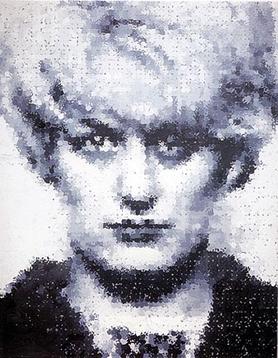
Marcus Harvey is an English artist and painter, one of the Young British Artists (YBAs).

Margaret Hannah Olley was an Australian painter. She was the subject of more than ninety solo exhibitions.
Carl Freedman is the founder of Carl Freedman Gallery. He previously worked as a writer and a curator.

An artist-run space or artist-run centre (Canada) is a gallery or other facility operated or directed by artists, frequently circumventing the structures of public art centers, museums, or commercial galleries and allowing for a more experimental program. An artist-run initiative (ARI) is any project run by artists, including sound or visual artists, to present their and others' projects. They might approximate a traditional art gallery space in appearance or function, or they may take a markedly different approach, limited only by the artist's understanding of the term. "Artist-run initiatives" is an umbrella name for many types of artist-generated activity.
Curtain Road Arts was an artist-run project housed in an old furniture warehouse in Shoreditch, London, which functioned as a studio and an art project space. It was a centre for a great deal of activity in the 1990s, and included artists such as Glenn Brown, Alex Landrum, Dermot O'Brien, Anya Gallaccio, Cornelia Parker, Angela Bulloch, Stephen Hughes, Dan Hays, Mariele Neudecker, Debbie Curtis, Emma Smith and Michael Stubbs. Curtain Road Arts also housed The Agency Gallery.

Terry Winters is an American painter, draughtsman, and printmaker whose nuanced approach to the process of painting has addressed evolving concepts of spatiality and expanded the concerns of abstract art. His attention to the process of painting and investigations into systems and spatial fields explores both non-narrative abstraction and the physicality of modernism. In Winters’ work, abstract processes give way to forms with real word agency that recall mathematical concepts and cybernetics, as well as natural and scientific worlds.
Margaret Harrison is an English feminist and artist whose work uses a variety of media and subject matter.

Derry O'Sullivan is an Irish poet living in Paris, France. He was born in 1944 in Bantry, Co. Cork, Ireland.

Christopher Piers Arthur Wardle was a British artist, musician and art factotum. Born in Beckenham, he lived in Southwark, London, UK and died in Clyst Hydon, Devon, UK.
Alexander Brattell is a British photographer best known for his abstract monochrome fine art prints which examine the role of visual perception in non-verbal thought.
Jean-David Malat is a London-based art dealer and curator and founder of the JD Malat Gallery located at 30 Davies Street, Mayfair, W1K 4NB.

Marie Hanlon is a Dublin-based Irish artist working in a variety of media including painting, drawing, sculpture, video and installation. She has collaborated with Irish composers, most notably Rhona Clarke, in creating works which can be realised in both concert performance and gallery situations.
The Southern States Art League, originally called the All-Southern Art Association, was formed in the 1920s to draw attention to artists from the southern United States. A number of its early members were closely associated with the Charleston Renaissance, and it has been credited with helping to establish the South as "a viable art center and formidable force in the realm of American culture."
Wrik Mead is an artist/filmmaker from Toronto, Ontario and teaches at OCAD University.

Jealous Print Studio is a print publisher and studio based in Shoreditch, East London. The studio collaborates with established artists, galleries, designers and museums in producing limited edition prints. The studio's clients include White Cube, Fine Art Society, Victoria and Albert Museum, ICA, Tate, Saatchi Gallery, The British Film Institute, and the Royal Academy of Arts.
Szabotage is a British urban artist and interior designer. He was born as Gustav Szabo in Brighton, grew up in Hove and London, studied architecture and worked as a designer. He relocated to Hong Kong, where he became active in the street art scene and began to gain notoriety in the local and international urban art world.
Taylor Galleries is a contemporary commercial art gallery in Dublin, Ireland.
Shin Gallery is an encyclopedic art gallery owned by Hong Gyu Shin. It specializes in modern and contemporary art, and hosts museum-quality exhibitions. It is located on the Lower East Side of Manhattan, New York, and opened in 2013. In 2014, an immersive project space was opened next to the gallery. In 2017 Shin Gallery expanded to include three different gallery spaces on Orchard Street. In 2020, Shin Haus was launched. Shin Haus is a program with the aim of discovering up-and-coming artists. Shin Gallery also specializes in rediscovering overlooked artists, traditionally marginalized due to their ethnicity and gender. Work is also done with a variety of venues including national heritage sites, hotels, and public spaces further demonstrating its international agenda.

The Pallas Projects/Studios(PP/S, Pallas Studios, Pallas Contemporary Projects) is an artist-run and non-commercial gallery and studio space in Dublin, Ireland.

The Olivier Cornet Gallery is a contemporary commercial art gallery in Dublin, Ireland, owned and run by French-born Olivier Cornet [ɔ.li.vje kɔʁ.nɛ].









